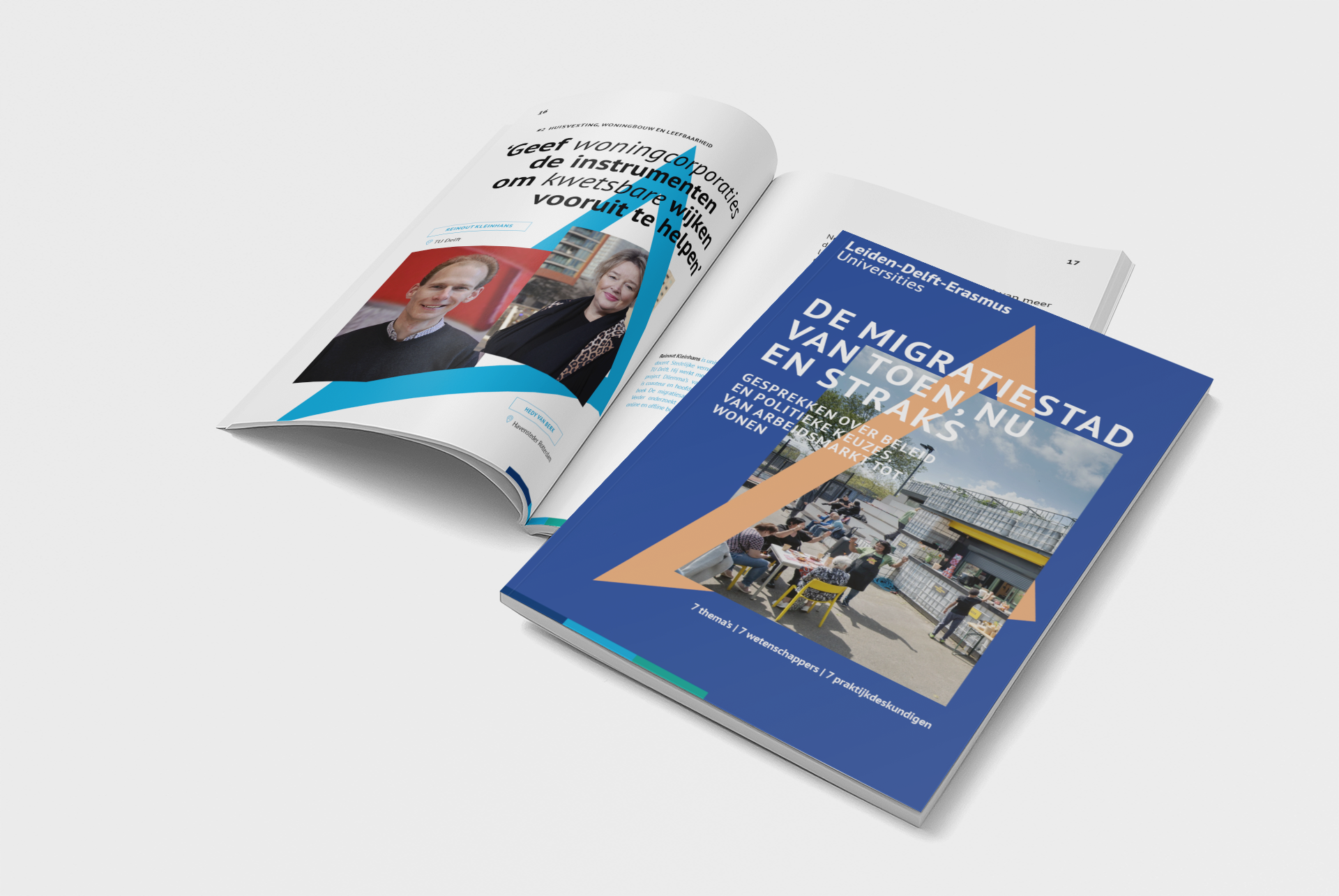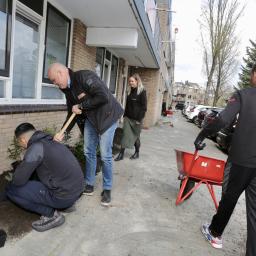Shocking images in 2023: asylum seekers forced to sleep outside at the registration centre in Ter Apel. Do the images show an asylum crisis or a reception crisis? And can the Dispersal Act bring relief? 'Provide permanent accommodation and offer asylum seekers the opportunity to integrate at an earlier stage,' argue COA advisor Anne Backer and researcher Elina Jonitz. By Maurice van Turnhout

Plans are afoot for asylum crisis legislation. Is there really an asylum crisis as such? Migration researcher Elina Jonitz: 'If you look purely at the number of asylum applications, the Netherlands is roughly in the mid-table of European countries. There is currently a slight spike, but not enough to justify alarmist language about an ‘asylum crisis’. Seeing the shocking images from Ter Apel, it is more accurate to describe it as a reception crisis. And that is the result of major cuts in public spending on the part of central government. “After 2015, when asylum migration declined, many asylum seekers’ centres were closed and COA staff redeployed, even though policymakers could have known that numbers would eventually rise again.'
Anne Backer (advisor at the COA, the central agency for the reception of asylum seekers): 'That’s correct. Had the COA received stable funding after 2015, we would still have had to work hard now, but it would not have come to such a reception crisis. Almost half of our asylum seeker residents are forced to stay in temporary shelters. These sites are two to three times more expensive than regular shelters. They are also of much lower quality. That affects their living conditions, and that in turn affects the surrounding area. Moreover, these sites are often set up only at the last minute, leaving the surrounding area feeling ambushed. This temporariness also means asylum seekers have to move far too often. This is bad for their mental health and does not help with their integration.'

At the asylum seekers' centre in Utrecht, there is a restaurant where asylum seekers work and local residents come to eat.'
How can policymakers defuse this framing of an ‘asylum crisis’? Backer: 'By putting in place the conditions for decent reception, because then you will get a more stable reception landscape. It is precisely at long-term reception locations that local residents are generally positive about the presence of an asylum seekers’ centre. At asylum seekers’ centres in Utrecht, Amsterdam, and Arnhem, for example, there is a café-restaurant, A Beautiful Mess, where asylum seekers work and where local residents come for a meal and a drink. At many reception locations, we have Meedoen offices where we work together with the NOV volunteer organisation, so that our residents can do volunteer work in their local area.'
Jonitz: 'I have done sociological research in four Dutch local authority areas in Drenthe, Overijssel, and the Randstad region. The smallest of these areas has had a permanent asylum seekers’ centre for almost thirty years. At the time, local residents were not very happy about it, but the centre has slowly become part of the village. There is support among residents and from the local authority. From examples like that, I draw hope.'

'It is striking, however, that acceptance by local residents often depends on very site-specific factors. In one small Dutch town, for example, I noticed that residents were annoyed that asylum seekers with residence permits often kept their curtains closed during the day. In a large city like Rotterdam, it would not be an issue for people, but in that small town it upset people immensely. So you have to take that kind of local context into account when dispersing, receiving, and integrating asylum seekers, including those with residence permits.'
Will a Dispersal Act that requires local authorities to accommodate a percentage of asylum seekers help relieve the reception crisis? Backer: 'In the long term, the Dispersal Act is really going to help us build a stable shelter landscape with more long-term locations, properly distributed across the country. That is why the COA supports the Dispersal Act. Indeed, we very much need this law to be able to perform our most basic tasks. At present, there are simply no other solutions available, at least not legally defined ones.'
A poorer reception system ensures that people end up integrating less well.'
Jonitz: 'It is difficult to predict how the Dispersal Act will work out in practice, as it will not have exactly the same impact in any local context. That said, I also expect that some crucial challenges can be better addressed with the help of the Dispersal Act. We tend to think of asylum policy and integration as two different pillars, when in reality they overlap. Asylum seekers are now often forced to move from one temporary place to another, making it harder for them to integrate. Employers do not invest in people who could be sent to the other side of the country at any moment. Policymakers struggle with the fact that asylum seekers cannot move on to the housing market.'

'The system deliberately uproots these people, but once they are admitted, the government then requires them to integrate as quickly as possible. The Dispersal Act will overcome some of these issues by providing more permanent shelter. As a result, local authorities become involved at an early stage in the cycle, from refugee reception to the integration of asylum seekers who have been granted residence permits. Once local authorities start to see the reception, housing, and integration of migrants as interrelated and not as separate processes, they will also become more aware of the need for social participation by the residents of asylum seekers’ centres.'
The Arnhem city council is receiving more asylum seekers at its own initiative than is required under the Dispersal Act. Asylum seekers are also being given the opportunity to participate more there. So should other local authorities follow suit? Jonitz: 'It’s a good start. Newcomers often do not know their way around their new environment, they are insecure, there is a language barrier. In Stuttgart, I worked at the Welcome Center, where I was able to show newcomers around and put them in touch with civic organisations, businesses, and volunteer work. That initiative was supported by the local authority, among others. But you can only encourage something like that in shelters that are permanent, and ultimately both the existing community and the newcomers benefit.'
'Unfortunately, politicians keep claiming that you have to cut down on asylum reception because otherwise the Netherlands will have too much of a pull factor for migrants. There is no scientific evidence whatsoever for that notion. Refugees make decisions about their final destination along the way, under the pressure of a lot of stress, and they register in places where they already have social contacts.'
Better reception is a matter of carefully weighing up the risks and it is morally right.'
Backer: 'Having poorer reception facilities means in practice that people who do come here integrate less well. In the long run, this only causes more problems. So it is better to accommodate people well and provide opportunities for integration than to try to deter a few. That is not just a matter of carefully weighing up the risks, it is also morally right. The bulk of residents of asylum centres in the Netherlands are people fleeing war and violence; we must be able to accommodate them properly. That humanitarian aspect is often forgotten in the discussion on the costs and benefits of migration.'
Elina Jonitz is a PhD candidate in the Public Administration and Sociology department of Erasmus University Rotterdam. She is researching the integration of migrants and refugees in the Netherlands. She previously worked as a consultant at the Welcome Center in Stuttgart, Germany.
Anne Backer is an advisor at the COA, the central agency for the reception of asylum seekers). She works on national advocacy projects for a future-proof asylum reception system, so that the COA can improve the reception and supervision of asylum seekers. In the interview, she speaks in a personal capacity.
 White paper 'The migration city of then, now and later'
White paper 'The migration city of then, now and later'
This article is from the sixth white paper of Leiden-Delft-Erasmus Universities. If you would like to copy one or more texts, please contact Katja Hoiting k.hoiting@tudelft.nl.
Sender of this edition is the Leiden-Delft-Erasmus Centre Governance of Migration and Diversity, founded in 2020 to conduct interdisciplinary research on the governance issues surrounding migration, diversity and inequality.








